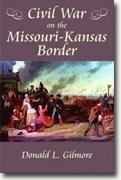Civil War on the Missouri-Kansas Border
Donald L. Gilmore
book reviews:
· general fiction
· chick lit/romance
· sci-fi/fantasy
· graphic novels
· nonfiction
· audio books
· author interviews
· children's books @
curledupkids.com
· DVD reviews @
curledupdvd.com
newsletter
win books
buy online
links
home
for authors
& publishers
for reviewers

 |
Civil War on the Missouri-Kansas Border Donald L. Gilmore Pelican Paperback 384 pages November 2005 |
|
The term “Jayhawk” is mostly recognizable nowadays as the University of Kansas’s birdlike mascot. The term actually refers, though, to anti-slavery proponents who violently opposed to slavery in Kansas. Many of these Jayhawks were from New England, some of them sponsored to move to Kansas to help bring that territory into the Union as a free state. They did not, however, stay in Kansas; they went into slave-holding Missouri and raided towns, farms, and plantations trying to free slaves. This was known as “Jayhawking” and happened both before and during the Civil War.
The term “bushwacker” refers to proponents of slavery. Many Kansan and Missourian bushwackers were forced into becoming that role to defend their property and their very lives. Some famous bushwackers are William C. Quantrill, Jesse James, Bill “Bloody Bill” Anderson and Cole Younger. Bushwackers, guerillas, and raiders with Quantrill were cast as lowlife scum by abolitionist propagandists. In fact, as Gilmore shows, these young men simply decided to stand up for their property and their rights against the abolitionists. Many were members of the western Missouri elite and were well educated. The raiders had support from the majority of western Missouri, most of whom were family members. When the Civil War started up, pro-slavery men joined either the Confederate Army or groups of guerillas eventually commanded by William Quantrill. The raiders or guerillas had received recognition from the Confederate government, but the Federal Army and its supporters did not recognize them as being of the Confederate organization. As a result, they were treated as outlaws and hunted down like dogs. No quarter or mercy was given to them; they were not treated as prisoners of war and usually executed on the spot. The guerillas retaliated in kind. Donald Gilmore’s more accurate look at Jayhawks and so-called Bushwackers is part of his effort to correct harsh propaganda against Confederates. He points out that the reputations of guerillas like Quantrill were smeared to make them appear evil and corrupt. As in the case of all wars, the winner writes the history. Gilmore reveals what propagandists did to degrade the guerillas and the pro-slavery people of Missouri and Kansas. Some of this false propaganda persists to this day. Gilmore admits that he has no Southern ancestry to motivate him to defend the guerillas. His examination of this horrible period of Kansas and Missouri history is enlightening to the reader. Gilmore provides maps, illustrations especially photos from the time period, endnotes, a bibliography and an index. This well-written book is recommended to those interested in the Civil War, Kansas and Missouri history, and guerrilla warfare. Donald L. Gilmore earned his B.A. and M.A. in English from the University of Missouri in Kansas City. He worked as an editor at the U.S. Army’s Combat Studies Institute. He served as a consultant for the Civil War movie Ride With the Devil and has written articles for the Journal of the West, History Today, and Wild West. Originally published on Curled Up With A Good Book at www.curledup.com. © Br. Benet Exton, O.S.B., 2008 |
|
|
|
 Click here to learn more about this month's sponsor! |
|
| fiction · sf/f · comic books · nonfiction · audio newsletter · free book contest · buy books online review index · links · · authors & publishers reviewers |
|
| site by ELBO Computing Resources, Inc. | |
 Some famous Jayhawks included Senator James Lane, who became a Union general, and Daniel R. Anthony, the brother of the famous suffragette Susan B. Anthony. At times not very nice to their opponents, they robbed and destroyed their property, including their slaves. They even killed some of their opponents. The infamous John Brown and some of his followers started their murderous trail in Kansas and later moved to traitorous actions at Harper’s Ferry in Virginia. Some Jayhawks became powerful politicians in the Kansas state government.
Some famous Jayhawks included Senator James Lane, who became a Union general, and Daniel R. Anthony, the brother of the famous suffragette Susan B. Anthony. At times not very nice to their opponents, they robbed and destroyed their property, including their slaves. They even killed some of their opponents. The infamous John Brown and some of his followers started their murderous trail in Kansas and later moved to traitorous actions at Harper’s Ferry in Virginia. Some Jayhawks became powerful politicians in the Kansas state government.